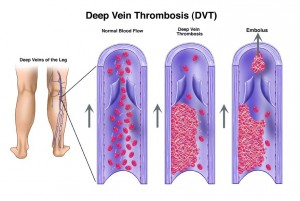 You may have heard of deep vein thrombosis (DVT) on TV or from talking with friends or family members. This type of blood clot is commonly discussed by health professionals due to its common nature and serious complications. Similar to many other medical issues, this problem is easier to avoid than to treat. At the Chicago Vein Care Center, we encourage our patients to learn more about DVT in order to take steps to prevent it.
You may have heard of deep vein thrombosis (DVT) on TV or from talking with friends or family members. This type of blood clot is commonly discussed by health professionals due to its common nature and serious complications. Similar to many other medical issues, this problem is easier to avoid than to treat. At the Chicago Vein Care Center, we encourage our patients to learn more about DVT in order to take steps to prevent it.
What should Illinois patients know about deep vein thrombosis?
Deep vein thrombosis is a type of blood clot that occurs in veins deep inside the body, most commonly in the legs. Blood clots occur when blood becomes thicker and clumps together. This can happen for a number of reasons, including prolonged bed rest, pregnancy, injury, or sitting for long periods of time. These clots may block off veins in the lower leg and thigh, causing pain, swelling, and skin redness and warmth. However, DVT does not always appear with symptoms, making diagnosis difficult in some cases.
While DVT can cause some problems in its initial stages, it is most dangerous due to its complications. Part of this clot can break off and travel through the blood stream. This loose clot, called an embolus, can travel to the heart, lungs, and brain, blocking blood flow and causing serious damage. When an embolus travels to the lungs it may cause a pulmonary embolism, a potential fatal condition that requires immediate medical care. Common warning signs of a pulmonary embolism include chest pain, dizziness, and an unexplained shortness of breath.
How can deep vein thrombosis be prevented?
Taking steps to prevent DVT is an effective way to protect yourself from this problem. One step you can take is to avoid situations that encourage blood clot formation, such as sitting for an extended period of time. If you are anticipating driving or flying a long distance in the near future, invest in a pair of compression stockings. These stockings apply helpful pressure to the legs, promoting healthy circulation and reducing the risk of blood clots. Take regular breaks while traveling to get up and walk around. This also helps to keep blood moving and reduces the risk of clots.
Many of the steps you can take to prevent DVT are the same steps that will help prevent bulging vein problems. If you are overweight or obese, managing your weight can help reduce your risk of blood clots. The same can be said of exercising on a regular basis. Quitting smoking has a positive effect on many aspects of health, including lowering your risk of DVT.
Finally, you can lower your risk of DVT by carefully following your doctor’s instructions after undergoing surgery. You may be prescribed blood thinners after undergoing surgery: be sure to take them as directed. If you are on bed rest after surgery or for other reasons, get up and move as soon as your doctor tells you to. Following your doctor’s instructions can make a huge difference in your risk of deep vein thrombosis.
If you believe you are at risk for DVT, speaking with a spider vein specialist such as Dr. Ramon Castro can help. He can help diagnose your problem and advise on an appropriate form of vein treatment. Working with a varicose vein center gives you access to resources that will help you prevent and treat vein issues, allowing you to enjoy better overall health. If you have any questions about deep vein thrombosis, the cost of spider vein treatment or any other varicose vein treatment, please don’t hesitate to give our Chicago, IL office a call. We look forward to meeting with you!
